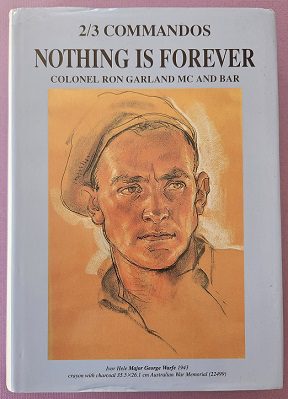Description
Title: Nothing is Forever – The History of 2/3 Commandos
Author: Garland, Ron
Condition: Near Mint
Edition: 1st Edition
Publication Date: 1997
ISBN: 0646319442
Cover: Hard Cover with Dust Jacket – 444 pages
Comments: The comprehensive history of the No. 3 Independent Commando Company.
Having completed its training at Foster on Wilson’s Promontory, Victoria, the 2/3rd Independent Company travelled north to Katherine, in the Northern Territory. Following Japan’s entry into the war, as with the 1st and 2nd Independent Companies that were sent to New Britain and Timor, in December 1941, the 2/3rd was sent to New Caledonia.
The 2/3rd was to only garrison New Caledonia as a temporary measure, until they could be relieved by a much larger American division. When the Americans arrived though, the US divisional commander was so impressed with the independent company type of training that he sought to retain the 2/3rd so they could retrain his division. When the 2/3rd was withdrawn and returned to Australia at the start of August 1942, the divisional commander sought the retention of the 2/3rd’s commander, Major George Matheson and he was promoted to lieutenant-colonel.
After six months in Australia, the 2/3rd sailed for New Guinea in the middle of February 1943. The 2/3rd saw extensive service in New Guinea where, under the skilled leadership of Major George Warfe, it performed very well. From Moresby the company was flown to Wau, participating in the Australian pursuit of the Japanese towards Mubo. When the company moved to Missim, they waged a guerrilla war against the Japanese who were around the Komiatum Track, in support of the 3rd Division’s campaign around Salamaua.
The terrain over which the company fought during the Wau-Salamaua campaign was dense with jungle covered rugged mountains. They patrolled deep into Japanese territory, setting ambushes and gathering intelligence. The 2/3rd also made a number of attacks against Japanese positions, most notably in May, when a strengthened platoon captured Ambush Knoll, which controlled Bobdubi Ridge and threatened the Japanese supply lines to Mubo and Salamaua. The Japanese made a fierce counter attack, but for three days and four nights, the 52 commandoes on the knoll held off the Japanese attackers.
The 2/3rd received high praises for its part in the Wau-Salamaua campaign, but it cost them heavily. Credited with having killed 969 Japanese, the 2/3rd suffered 65 battle fatalities and 119 wounded. Another 226 men were also evacuated for medical reasons. Only the meagre flow of reinforcements allowed the unit to continue. Indeed, by the time campaign was over, there were only 34 men were left from the original group that had flown into Wau.
The 2/3rd was also immortalised on screen and canvas. During the campaign, the war artist Ivor Hele visited the company and took numerous sketches which were later produced as a series of paintings. Similarly, the war cameraman Damien Parer also spent time with the company and they featured prominently in his documentary Assault on Salamaua.
After the fall of Salamaua, in September, the 2/3rd returned to Australia and after leave, reformed on the Atherton Tablelands. This was a period of reorganisation for the independent companies as the 2/3rd, along with the 2/5th and 2/6th Independent Companies were brought together to form the 2/7th Cavalry (Commando) Regiment. In October the title independent company was changed to cavalry (commando) squadron, so the 2/3rd Independent Company become the 2/3rd Cavalry (Commando) Squadron. This name was later simplified to just commando squadron.
The 2/3rd did not go into action again until almost the end of the war. For the remainder of 1943, all of 1944 and into 1945, the 2/3rd remained on the Atherton Tablelands, where it trained and conducted exercises with the 7th Division.
Between May and July 1945, the 7th and 9th Divisions made a series of landings on Borneo as part of the OBOE operations. The first landing was made at Tarakan on 1 May by a brigade of the 9th Division, and the rest of the division landed at Brunei Bay and Labuan Island in June. The 7th Division landed at Balikpapan on 1 July.
Once the landing beach was secured, the 2/7th Cavalry (Commando) Regiment would support the 7th Division by moving off along Vasey Highway and capture the airfield at Seppinggang. The 2/5th Cavalry Squadron was to lead the way supported by the 2/3rd.
On the first day of the battle, the 2/3rd landed on Green Beach and moved off along Vasey Highway. But by 2 July it came under heavy mortar fire from the Japanese on Lady Schofield Knoll and they could not capture the position until the next day. On 4 July one of the squadron’s troops were transferred the 2/9th Infantry Battalion to patrol the area around Penadjam, while the rest of the squadron continued on to Seppinggang. On 27 July offensive operations ceased, and the squadron moved to Penadjam. The next month, in the middle of August, Japan surrendered, and the war was over.
At the end of December, the 2/3rd left Borneo and returned to Australia. In early 1946, in Chermside camp, Brisbane, the 2/3rd Commando Squadron was disbanded.
Includes Nominal Roll





